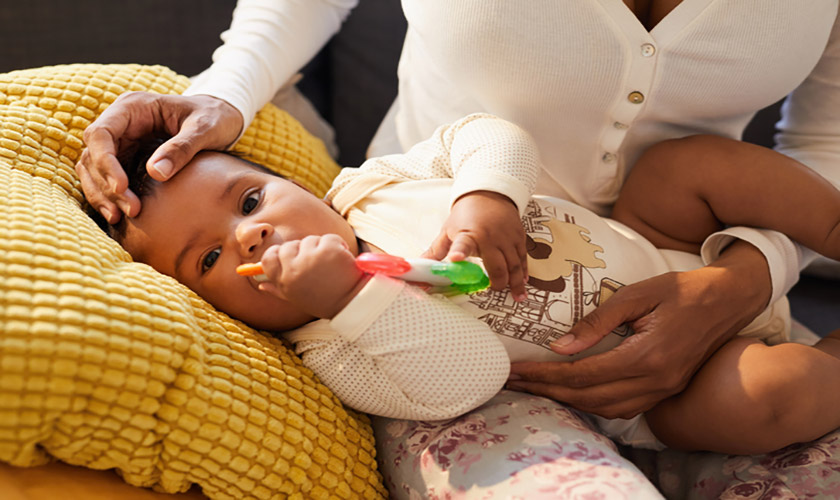
Every child who goes through the normal developmental stages will experience the teething phase. Your child is likely to begin the teething process when they are about six months old. However, some babies will start teething as early as three months, while others will experience the milestone as late as 12 months of age.
So, you shouldn’t worry too much if your kid’s teeth show up at what people consider the “wrong time,” provided most of them show up by your baby’s third birthday.
During the teething period, the toddler’s milk teeth will begin to erupt from the gums. The lower central incisors at the bottom front tend to show up first, followed by the top front teeth two months later. And the lateral incisors may come out at about nine months of age. Then they are followed by the first molars at the back and the eyeteeth at the upper jaw.
In the end, your child will have 10 upper and 10 lower baby teeth that will help them chew and speak. These teeth also come in handy when a child wants to smile. In addition, they will give your kid’s face its form and shape. And they will begin to fall out when your child is about six years of age, at which point, the permanent teeth will start to replace them.
Unfortunately, the process of teeth growing is often a frustrating time. As a result, most children tend to feel pain. And the child’s pain may result in discomfort, pain, and sleepless nights for everyone concerned. Therefore, as a parent, you should have a good idea of teething symptoms in toddlers and how to provide them with pain relief and emotional support.

Common Symptoms of Teething in Toddlers
If you are lucky, your baby will be one that doesn’t experience any significant symptoms when teething. But the odds of that are pretty low. You are better off bracing yourself for any eventualities. So, you need to be on the lookout for the signs that the baby teeth are coming. Below are some of the common symptoms teething toddlers tend to show.
Drooling
The average baby drools quite a bit. But a teething baby tends to drool a lot. You will be wiping much more saliva than you are used to. Sometimes, your baby may even have a face rash from excessive drooling. When it dries, it may make their cheeks appear flushed. But it’s okay for your toddler to have that since saliva tends to protect the baby teeth from tooth decay.
However, if your child doesn’t look excessively ill, have a fever, or have trouble speaking, swallowing, or breathing, the odds are pretty high that you are about to see a new tooth.
Swollen and Sensitive Gums
When your baby’s gums are swollen or tender, then you are likely dealing with teething. It’s probably due to the baby teeth emerging.
In addition, you may notice your child attempting to chew on different objects or place their fingers in the mouth. All these actions are meant to try to ease the discomfort they are feeling on their gums.
Irritability or Crankiness
The more uncomfortable your baby feels because of swollen gums or irritated skin from drooling, the more irritable or cranky they will be. They may also have trouble sleeping, cry more often, and may experience a loss of appetite.
And sometimes, they may engage in ear pulling. If your child does this, don’t confuse that with an ear infection. When a child is teething, the chances are pretty high that the pulling on their ears will occur on the side the tooth is emerging from.
Increase in temperature
Generally, a high fever is not a sign of teething. And if your child shows such a symptom accompanied by a runny nose, loose stools, or diaper rash, you should visit the doctor as fast as possible so you can first rule out a possible infection that poses serious risks to your baby’s health.
However, some teething toddlers may have slightly elevated temperatures. But if those temperatures remain below 100.4 degrees Fahrenheit (via a rectal test), there’s no need to worry.

What to do for Your Teething Child
The good news is that you can reduce your toddler’s pain and discomfort when teething. Below are some of the things you can do to achieve that.
Reduce the Gum Discomfort
One of the easiest and quickest things you can do for your toddler is gently massage your child’s gums, using a clean finger to ease the discomfort caused by the emergence of a new tooth. You can also use a wet gauze pad (dip it in cold water, but it should not be soaking wet) to soothe your baby’s gums and ease their pain. But a chilled or cold spoon (not frozen) could work just as well.
Give Your Baby Something to Chew
Teething toddlers like to chew on objects because it soothes their gums. So, it would be best if you give them something safe. For example, give your toddler chilled plastic or hard rubber toys, such as teething rings or pacifiers, to reduce gum soreness.
Alternatively, you can dampen a washcloth, twist, freeze, and tie a knot on one of its ends to make it easier for the baby to chew on it. Again, the cold helps to reduce gum inflammation.
It is also a good idea to give your toddler cold foods like raw fruits and vegetables, such as bananas if they have already started taking solid foods. But a crust of bread or plain yogurt could also work. And be sure to watch out for your child when they feed, so they don’t choke.
Wipe Off the Dribble
Remember, excessive drooling may dry on your child’s face and end up causing rashes, irritation, and flushed cheeks. So, when your teething toddler starts to produce extra saliva, arm yourself with a piece of cloth and wipe it off often. Then apply a moisturizer, such as petroleum jelly.
Comfort Your Toddler
When a baby is feeling irritable or cranky due to teething, you can provide emotional support by playing and comforting them. Also, they tend to feel much better when they are cuddled in their parent’s arms.
Medicate the Pain Away
If your toddler is struggling with the teething process, you may want to contact your pediatrician concerning the over-the-counter medication you can buy and use to relieve the pain.
Generally, some types of medication are acceptable for teething toddlers. These include ibuprofen (Advil, Motrin, etc.) and acetaminophen (Tylenol, etc.). The former can be taken by children aged six months or older, while the latter is a much safer option that babies as young as two months of age can take.
What to Avoid When Dealing with a Teething Toddler
Not every product out there is suitable for a teething toddler. The U.S. Food & Drug Administration (FDA), as well as American Academy of Pediatrics (AAP), issues warnings against some of these products because they are likely to affect your baby’s health negatively. Below are some things you should stay clear of when your child’s teething.
Teething Gels and Creams
Teething gels work by numbing the baby’s gums. But, according to the FDA, many products contain benzocaine, a local anesthetic, which is pretty useless because it can be washed out of the baby’s mouth within minutes.
However, the greatest danger with benzocaine products lies in their ability to reduce the red blood cell’s capacity to carry oxygen. When that happens, the affected person develops a blood disorder known as methemoglobinemia, which can be severe or fatal.
So, you may want to avoid all topical teething treatment products because they may contain benzocaine. You may want to watch out for brands like Topex, Cepacol, Chloraseptic, Anbesol, Baby Orajel, Orajel Hurricaine, and Orabase.
Oral Viscous Lidocaine
The FDA recommends that parents and caregivers avoid using oral viscous lidocaine to treat teething children. If your toddler accidentally swallows too much of the solution, they will experience seizures, heart problems, and severe brain injuries. And in the worst-case scenario, the baby might end up dead.
Homeopathic Teething Tablets
It would also be best to avoid homeopathic teething tablets. In 2017, the FDA warned that some of those products contained excess amounts of the active ingredient known as belladonna, which comes from the poisonous nightshade plant. Others contain coffea cruda or caffeine levels that are outside the normal manufacturing ranges.
According to the FDA, using teething tablets containing excess amounts of belladonna may cause adverse events, such as seizures, agitation, muscle weakness, urination difficulty, skin flushing, lethargy, and excessive sleepiness.
Teething Jewelry
The FDA and the American Academy of Pediatrics warn against teething jewelry, such as necklaces and bracelets. Most of them are made of amber, wood, silicone, or marble and claim to relieve teething pain. However, they do not.
When the toddler wears teething necklaces, they become strangulation hazards. They may end up strangling your baby to death while they are sleeping or when left unsupervised.
Teething bracelets and necklaces are also choking hazards. If your toddler breaks the jewelry apart and swallows some of the beads, they may end up choking to death or requiring a visit to the emergency department to remove them.
Child-Unfriendly Chew Toys
Child unfriendly chew toys include those that are damaged or filled with liquids. The latter may break, and your toddler may consume the fluid, which may be bad for their health.
You should also avoid freezing your baby’s chew toys because they will become hard and may hurt your baby’s already sensitive gums. Instead, chill it just enough to reduce gum inflammation and relieve your toddler’s pain.
Aspirin in All Forms
Whatever you do as a parent or caregiver, avoid giving any child aspirin in whatever form, including rubbing it against sensitive gums. Of course, older children over three years may take it. But it would be best to avoid giving it to older children recovering from chicken pox or flu.
Aspirin is suspected of causing Reyes Syndrome, which can cause liver and brain swelling. Some of the symptoms of the disease include seizures, loss of consciousness, and confusion. And without treatment, it can be fatal.
Since the disease is more common among children who have consumed aspirin, it is best to avoid it when treating a teething toddler’s symptoms.
The emergence of new teeth is just another developmental milestone that children go through. But whether your toddler passes through the teething period with minimal problems depends on your approach to dealing with how they feel.
If you can identify the teething symptoms of a toddler early, you can find the best strategies to deal with them so that they experience pain relief and get emotional support from you. But it is also wise to find out what you should avoid doing or using when a child is teething. That way, you won’t endanger their life.

